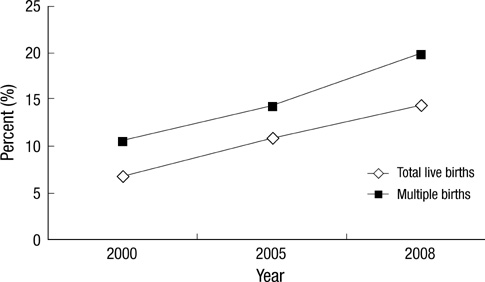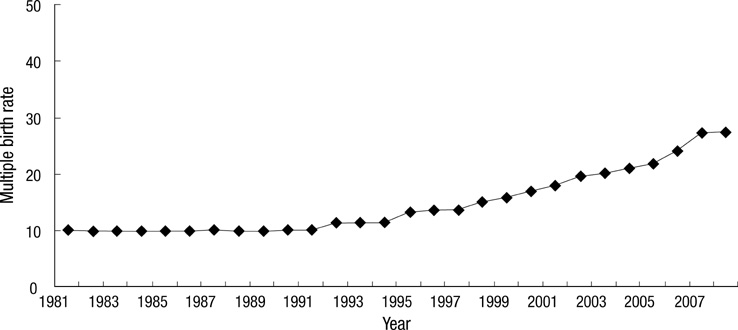J Korean Med Sci.
2010 Aug;25(8):1191-1196. 10.3346/jkms.2010.25.8.1191.
Recent Trends in the Incidence of Multiple Births and Its Consequences on Perinatal Problems in Korea
- Affiliations
-
- 1Department of Pediatrics, Kyung Hee University School of Medicine, Seoul, Korea. baecw@khnmc.or.kr
- KMID: 1714042
- DOI: http://doi.org/10.3346/jkms.2010.25.8.1191
Abstract
- The aim of this study was to survey multiple birth data and to analyze the recent trends of multiple births and its consequences on perinatal problems in Korea from 1991 to 2008. Data were obtained from the Korean Statistical Information Service. The total number of multiple births showed increasing trends. The multiple birth rate was maintained within less than 10.0 for the decade from 1981 to 1990. However, it increased gradually to reach 27.5 in 2008. The maternal age for multiple births was higher than for total live births. The mean birth weight of the total live births was 3.23 kg; for the multiple births it was 2.40 kg in 2008. The incidence of low birth weight infants (LBWI) among total live births was 3.8% in 2000 and 4.9% in 2008. For multiple births it was 49.2% and 53.0% during the same years. The incidence of preterm births among total live births was 3.8% in 2000 and 5.5% in 2008; for the multiple births it was 38.3% and 51.5% during the same years. The incidence of multiple births and its consequences on perinatal problems (preterm, LBWI, and advanced-maternal age) have been increased steadily over the last two decades in Korea.
Keyword
MeSH Terms
Figure
Cited by 3 articles
-
Trends in Birth Weight and the Incidence of Low Birth Weight and Advanced Maternal Age in Korea between 1993 and 2016
Hye-Eun Kim, In Gyu Song, Sung-Hoon Chung, Yong-Sung Choi, Chong-Woo Bae
J Korean Med Sci. 2019;34(4):. doi: 10.3346/jkms.2019.34.e34.Changes in neonatal outcomes in Korea
So Young Kim
J Korean Med Assoc. 2016;59(7):498-505. doi: 10.5124/jkma.2016.59.7.498.Pregnancy outcomes in twin pregnancies over 10 years
Junghyun Jee, Su Jung Hong, Sungyeon Ha, Ho Yeon Kim, Ki Hoon Ahn, Soon-Cheol Hong, Min-Jeong Oh, Hai-Joong Kim, Geum Joon Cho
Obstet Gynecol Sci. 2023;66(1):20-25. doi: 10.5468/ogs.22232.
Reference
-
1. Wenstrom KD, Gall SA. Incidence, morbidity and mortality, and diagnosis of twin gestations. Clin Perinatol. 1988. 15:1–11.
Article2. Loos RJ, Derom C, Derom R, Vlietinck R. Determinants of birthweight and intrauterine growth in liveborn twins. Paediatr Perinat Epidemiol. 2005. 19:Suppl 1. 15–22.
Article3. Kim NO, Choi SJ, Han KH, Hyung HS, Shin SR. Birth weight distribution of twins according to gestational age. Korean J Obstet Gynecol. 2004. 47:1860–1864.4. Lee KH, Hwang SJ, Kim SH, Lee SH, Yu DK, Hwang JH, Choi CW, Shim JW, Chang YS, Park WS. Comparison of mortality and morbidity in multiple versus singleton very low birth weight infants in a neonatal intensive care unit. J Korean Med Sci. 2003. 18:779–782.
Article5. Kliegman RM, Behrman RE, Jenson HB, Stanton BF. Nelson textbook of pediatrics. 2007. 18th ed. Philadelphia: Saunder Elsevier;699–700.6. Allen VM, Wilson RD, Cheung A. Genetics Committee of the Society of Obstetricians and Gynaecologists of Canada (SOGC). Reproductive Endocrinology Infertility Committee of the Society of Obstetricians and Gynaecologists of Canada (SOGC). Pregnancy outcomes after assisted reproductive technology. J Obstet Gynaecol Can. 2006. 28:220–250.
Article7. Blondel B. Increase in twin maternities and consequences on health. J Gynecol Obstet Biol Reprod. 2009. 38:S7–S17.8. Blondel B, Kogan MD, Alexander GR, Dattani N, Kramer MS, Macfarlane A, Wen SW. The impact of the increasing number of multiple births on the rates of preterm birth and low birthweight: an international study. Am J Public Health. 2002. 92:1323–1330.
Article9. Han M, Park ES. The clinical outcome of twin pregnancies after IVF. Korean J Reprod Med. 2007. 34:173–178.10. Blondel B, Kaminski M. The increase in multiple births and its consequences on perinatal health. J Gynecol Obstet Biol Reprod (Paris). 2002. 31:725–740.11. Dunn A, Macfarlane A. Recent trends in the incidence of multiple births and associated mortality in England and Wales. Arch Dis Child Fetal Neonatal Ed. 1996. 75:F10–F19.
Article12. Japan Ministry of Health, Labour and Welfare. accessed on 15 January 2010. Available from: URL: http://www.mhlw.go.jp/toukei/index.html.13. Lee SH, Kim OY, Seo SS. Clinical study on twins. J Korean Pediatr Soc. 1993. 36:1663–1671.14. Lee GR, Park KH, Park JS, Lee WM, Cha JY, Kim HH, Park MI, Cho SH, Chung SR. Statistical analysis of twin pregnancy for 10 Years (1993~2002). Korean J Obstet Gynecol. 2003. 46:1957–1964.15. Hur YM, Kwon JS. Changes in twinning rates in South Korea: 1981-2002. Twin Res Hum Genet. 2005. 8:76–79.
Article16. Korean Statistical Information Service. accessed on 15 January 2010. Available from: URL: http://www.kosis.kr.17. Chang YS, Lee JY, Moon SY, Kim JG. Pregnancy and its outcome by in vitro fertilization of human oocytes and embryo transfer. Korean J Obstet Gynecol. 1986. 29:354–361.18. Moon SY, Kim BR, Kim SH, Son YS, Lee KS, Lee BI, Lee SH, Lee YI, Jeon SS, Choi YM, Hwang TY. Current status of assisted reproductive technology in Korea for 1994. Korean J Obstet Gynecol. 1998. 41:236–253.19. ART committee, Korean Society of Obstetrics and Gynecology. Current status of assisted reproductive technology in Korea, 2006. Korean J Obstet Gynecol. 2009. 52:1212–1238.20. Kim HM, Lee JW, Shin SH, Kim SK, Sung TJ. Comparison of neonatal outcomes between the spontaneous and in vitro fertilization twin pregnancies. Korean J Pediatr. 2007. 50:740–745.
Article
- Full Text Links
- Actions
-
Cited
- CITED
-
- Close
- Share
- Similar articles
-
- Trends in Birth Weight and the Incidence of Low Birth Weight and Advanced Maternal Age in Korea between 1993 and 2016
- Maternal, infant, and perinatal mortality statistics and trends in Korea between 2018 and 2020
- Infant, maternal, and perinatal mortality statistics in the Republic of Korea, 2014
- Study on Multiple Birth Based on Birth Certificate Data
- Perinatal Mortality rates: IV. A Practical Classification of Infants by Birth weight and Gestational Age





